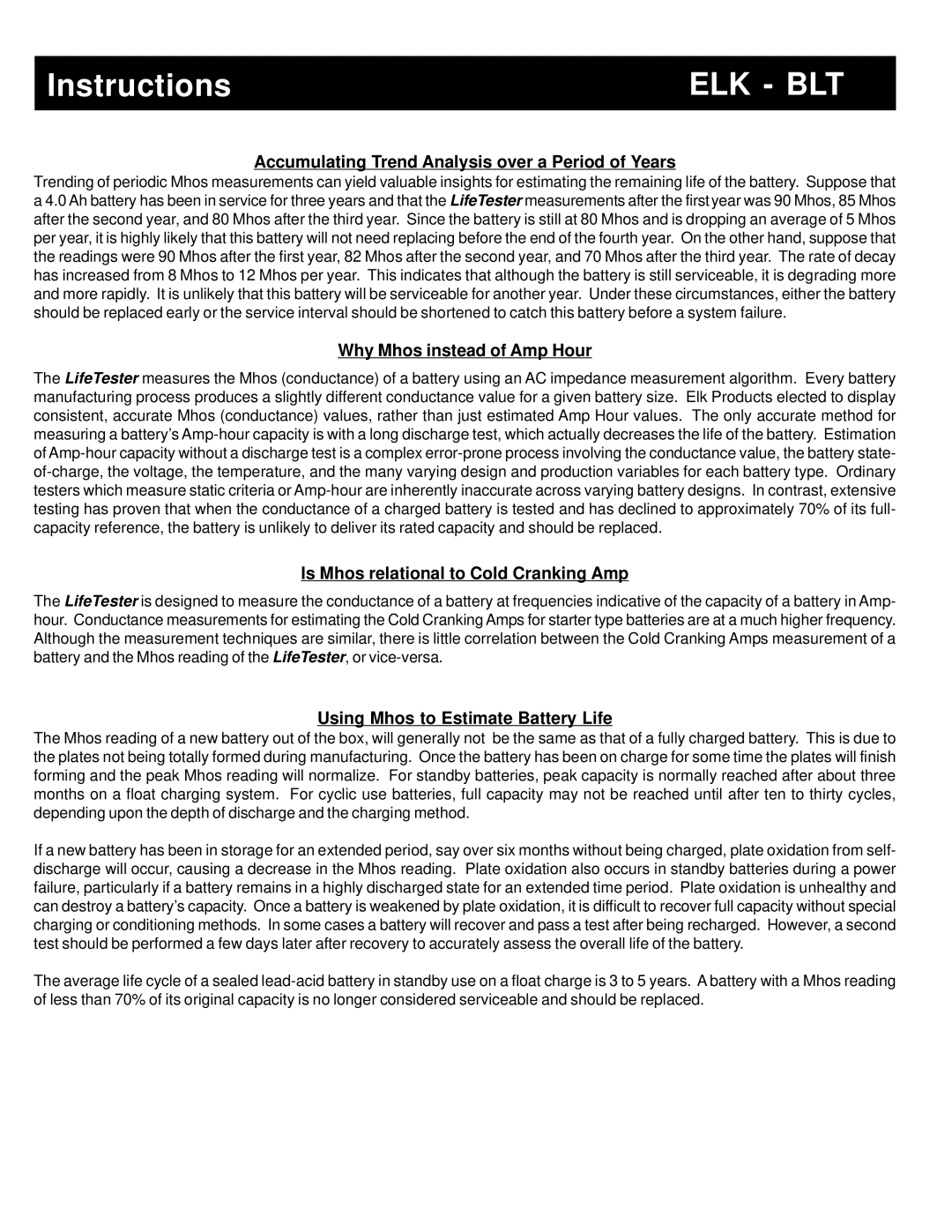Instructions | ELK - BLT |
|
|
Accumulating Trend Analysis over a Period of Years
Trending of periodic Mhos measurements can yield valuable insights for estimating the remaining life of the battery. Suppose that a 4.0 Ah battery has been in service for three years and that the LifeTester measurements after the firstyear was 90 Mhos, 85 Mhos after the second year, and 80 Mhos after the third year. Since the battery is still at 80 Mhos and is dropping an average of 5 Mhos per year, it is highly likely that this battery will not need replacing before the end of the fourth year. On the other hand, suppose that the readings were 90 Mhos after the first year, 82 Mhos after the second year, and 70 Mhos after the third year. The rate of decay has increased from 8 Mhos to 12 Mhos per year. This indicates that although the battery is still serviceable, it is degrading more and more rapidly. It is unlikely that this battery will be serviceable for another year. Under these circumstances, either the battery should be replaced early or the service interval should be shortened to catch this battery before a system failure.
Why Mhos instead of Amp Hour
The LifeTester measures the Mhos (conductance) of a battery using an AC impedance measurement algorithm. Every battery manufacturing process produces a slightly different conductance value for a given battery size. Elk Products elected to display consistent, accurate Mhos (conductance) values, rather than just estimated Amp Hour values. The only accurate method for measuring a battery’s
Is Mhos relational to Cold Cranking Amp
The LifeTester is designed to measure the conductance of a battery at frequencies indicative of the capacity of a battery in Amp- hour. Conductance measurements for estimating the Cold Cranking Amps for starter type batteries are at a much higher frequency. Although the measurement techniques are similar, there is little correlation between the Cold Cranking Amps measurement of a battery and the Mhos reading of the LifeTester, or
Using Mhos to Estimate Battery Life
The Mhos reading of a new battery out of the box, will generally not be the same as that of a fully charged battery. This is due to the plates not being totally formed during manufacturing. Once the battery has been on charge for some time the plates will finish forming and the peak Mhos reading will normalize. For standby batteries, peak capacity is normally reached after about three months on a float charging system. For cyclic use batteries, full capacity may not be reached until after ten to thirty cycles, depending upon the depth of discharge and the charging method.
If a new battery has been in storage for an extended period, say over six months without being charged, plate oxidation from self- discharge will occur, causing a decrease in the Mhos reading. Plate oxidation also occurs in standby batteries during a power failure, particularly if a battery remains in a highly discharged state for an extended time period. Plate oxidation is unhealthy and can destroy a battery’s capacity. Once a battery is weakened by plate oxidation, it is difficult to recover full capacity without special charging or conditioning methods. In some cases a battery will recover and pass a test after being recharged. However, a second test should be performed a few days later after recovery to accurately assess the overall life of the battery.
The average life cycle of a sealed
